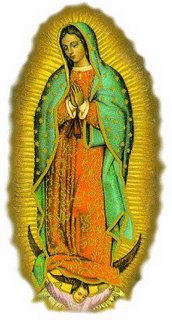... the streetwise lingo represented the playwright's attempt at what theologians call an "inculturation of the Bible--that is, a translation of the Gospel texts not simply into a different language but for a different culture.
For Guirgis, that culture is contemporary urban life. Hence, his saints and apostles speak (and often shout) as if they were standing on a crowded subway platform at rush hour. Freed from the need to provide historically accurate quotations for his characters, Guirgis deploys such language to reveal the essential nature of his characters in surprising ways.
For example when the defense attorney in Judas faces difficulty in getting Judas's case heard before a judge in the afterlife, she appeals to Saint Monica, the fourth-century woman whose relentless prayers are credited for the conversion of her wayward son, Augustine. In the biography Augustine of Hippo, church historian Peter Brown describes Monica as an "all-absorbing mother, deeply injured by her son's rebellions."
In Guirgis's world, a fiery Monica is a self-described nag who encourages the audience to seek her intercession: "I got a calling, y'all--you should try giving me a shout if ya ever need it, 'cuz my name is Saint Monica ... and ya know what? My ass gets results!"
Among some Jesuits, Guirgis's approach got results, too. After one performance, a friend said to me, "Maybe I should start praying to Saint Monica again."
A Jesuit Off-Broadway turned out to be one of my favorite books of the year. I am not alone as the book made Publishers' Weekly list for best books of the year (noted
here along with a link to a chapter pdf). Father James Martin wound up acting as theological consultant for the Off-Broadway play,
The Last Days of Judas Iscariot when Sam Rockwell, the actor portraying Judas, and the playwright, Stephen Guirgis, were directed to Father Martin for background and insights. Later, as the cast somewhat adopted him, Father Martin wound up acting as a unofficial chaplain to the group.
Father Martin leads a diverse group of actors in theology "classes," gives them biographies of saints, and helps them dig deeper into essential questions of faith in everyday life. In return, he finds their fresh approach to the Gospels and the main characters therein to be thought provoking. It can be enlightening for us as well to see how well the playwright encapsulates characters to give us fresh insights.
In Stephen's play, the defense attorney questions the high priest about his decision to hand over Jesus to the Roman authorities. Caiaphas responds with growing impatience:Our Torah has six hundred thirteen Sacred Laws--I can't even count how many Jesus broke or treated with wanton disregard and disdain! He broke the laws that came from the God of Abraham, Isaac, and Jacob! He violated the word of God. He violated the laws of Moses. He consorted with the Unclean, and women, and prostitutes. He performed Miracles on the Sabbath. He proclaimed himself Messiah! He forgave sin! Who was he to forgive sin?!Only God can do that! If that's not crossing the line, then I don't know what is!
..."Sometimes," explained Jeffrey [the actor portraying Caiaphas], "I would feel such rage on his behalf. Rage to the point of tears. Having to answer questions from the lawyers suggested that Caiaphas was less of a man, less of a human being, and even suggesting that he was evil."
As the play script develops and production begins, he not only takes us behind the scenes with him but shares how this all affects the actors with distinctly different religious backgrounds who are living their faith on widely differing levels. I especially liked the fact that Father Martin did not pass judgment on these people whatever their backgrounds but simply engaged them in conversation about the topic of the moment. Granted, those topics were generally Jesus, the saints, and Christianity. However, it gives us a good pattern for remembering how best to share our faith in our own lives, as Madeleine L'Engle put it:
We do not draw people to Christ by loudly discrediting what they believe, by telling them how wrong they are and how right we are, but by showing them a light that is so lovely that they want with all their hearts to know the source of it.
I also really enjoyed the way Father Martin uses the inspirations he realizes to make side trips into other, related subjects such as Jesuit theater, celibacy, Mary of Magdala, and the historical Jesus. I was also delighted when, after teasing us with snippets of the play throughout the book, Father Martin gives us a synopsis at the end. This is a play that I would have wanted to see and one in which I was deeply interested after reading about the actors and process.
Perhaps the best tribute to this book comes in the forward from the playwright who says that he didn't read the book as it is difficult to be a "character in someone else's story." That just made his testimony the more valuable.
... And along the way, Father Jim accomplished that thing that I hoped, and hope, to accomplish with the play itself: he got good people thinking about God again, and even got some back to the church. Even me.
Highly recommended to do that very thing, get us thinking about God in a new way. Christmas is coming. Get it for a theater lover you know.
Update:Busted Halo features a book excerpt focusing on the play's director, Philip Seymour Hoffman.
Read it here.





